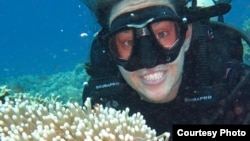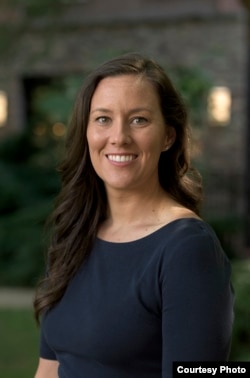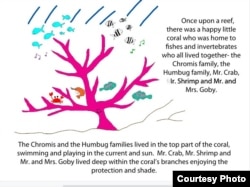Danielle Dixson's scientific research reads a bit like the famous Disney movie Finding Nemo.
Here's an excerpt: "Mr. and Mrs. Goby lived in their coral home and all of a sudden the coral started to get sick, but they needed their house to stay alive. So what would they do to help it?"
Dixson is a marine biologist who wanted to make her very legitimate, very important scientific research papers more accessible by turning them into children's books as a way to engage people in the fight against climate change.
It all started when the assistant professor at the University of Delaware was living in Fiji for almost two years, doing her post-doctoral research on the deterioration of coral reefs.
"A number of the reefs start converting from being this beautiful coral reef system that have a lot of holes for animals to hide in, into reefs [where] the coral [was] degrading and collapsing and there is not much hiding spaces for the fish and things like that," she said.
"So I'm trying to figure out how these transitions from healthy coral reefs to kind of degrading coral reefs are impacting the behavior of the fish species that live in those areas."
Scientific knowledge for all
Early on in her research, Dixson decided to get local people involved in her work.
"I was living, actually, in a village with some of the locals," Dixson explained. "It was a lot easier to get my research done if they understood what I was doing and how it would help them. One of the ways that I was able to connect with adults was I make these videos for them. I started making children's books for the kids so that they would have a better idea of why I was there, [so] that when I ask them not to walk through the baby pools that were there for experiment or something like that, that it would actually happen."
When she came back to the U.S, she decided to start doing the same thing for children in this country.
"I don't think kids should be left out of it and I thought that story books may be one of the easiest ways to sort of captivate them and have them to understand," she said.
Goby fights seaweed
Dixson has written nine books. One of them is about how that tiny goby saves his home.
The story was based on one of Dixson's studies.
"We do know that there is one species of the seaweed that if you put in contact with coral for 48 hours, the contact point of the coral will be dead," she said. "There are a number of organisms [that] live inside the coral, this tiny goby being one of them. So it was so interesting to see, since goby lives in the coral, that's really its home, it should have a vested interest in protecting its home.
“So I ran a series of experiments to figure out, does the goby help the coral fight the seaweed?” she said. “It ends up that they do. We found out that the coral actually can chemically communicate with the goby to tell it, like, come help me, I'm hurt right here."
When turning that research into a story, Dixson started by introducing young readers to Mr. and Mrs. Goby. Gobies are one of the world's largest fish families. More than 2,000 species of these small fish live in and help maintain the world's coral reefs, by eating invasive seaweed and generally keeping watch over these fragile ecosystems.
Dixson's story introduces readers to her the scientific findings, but in a way that creates a story about two gobies trying to save their home.
Inspiring, educating
As a marine scientist, Dixson wants her tales to be both educational and inspiring.
"One of the things I do in my all story books is I have a last page," she said. "And the last page talks about what you can do to help. … There is a lot of things that even a 6-year-old is able to do, whether it's shutting your lights off when you leave a room, or riding your bike to your friend's house instead of having your parents drive you. There is a lot of stuff that they can do and feel they're making a difference."
Dixson is collaborating with her students and the University of Delaware’s education and English departments to finish the project and publish the series.












